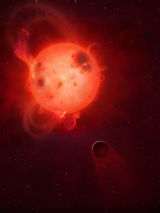What we do
Throughout history people of vision have wondered about the existence of extra-terrestrial life. However, despite valiant attempts (eg rovers on Mars, the SETI project) finding supporting evidence has proved elusive. Recent progress in science and technology suggests that we will soon be in a position to begin a systematic survey for biomarkers in the near universe. If life is relatively common in the Universe, existing on planets around at least one in a few thousand stars, we may well find it in the next decades.
With this background the study of extra-terrestrial environments suitable for habitation is set to become one of the most important scientific quests for mankind. These studies will be truly cross-disciplinary involving significant elements of astrophysics, biology, chemistry, geology, space and meteorological research. Furthermore, the detection of even the most simple organisms beyond the Earth will have a significant theological and philosophical impact on the human race. Indeed, the societal impact of the discovery of extra-terrestrial life could be transformative, but equally challenging for many communities, something that requires both academic study, but also action to educate and inform the population before the event.
A few specific questions we would like to address include:
1) What is the frequency of habitable zone rocky planets?
2) What factors dictate the habitability of a planet?
3) How does the composition of terrestrial planet atmospheres vary as a function of evolutionary age?
4) What are atmospheric bio-markers of both primitive life and advanced civilizations? How can they be detected?
5) What conditions give rise to the formation of life and how common are these in the Universe?
6) How common is life in the solar neighbourhood? What are the theological implications of the existence or non-existence of extra-terrestrial life?
7) How do the routes to finding life, and its likely properties when detected compare to the expectations of the public (as depicted e.g. in science fiction)?
8) What factors might dictate the lifetime of civilizations, and so the long term prospect of locating intelligent life

Image Credit:
Mark A Garlick / University of Warwick
